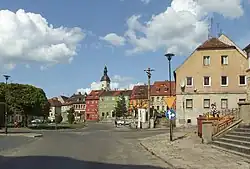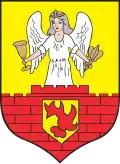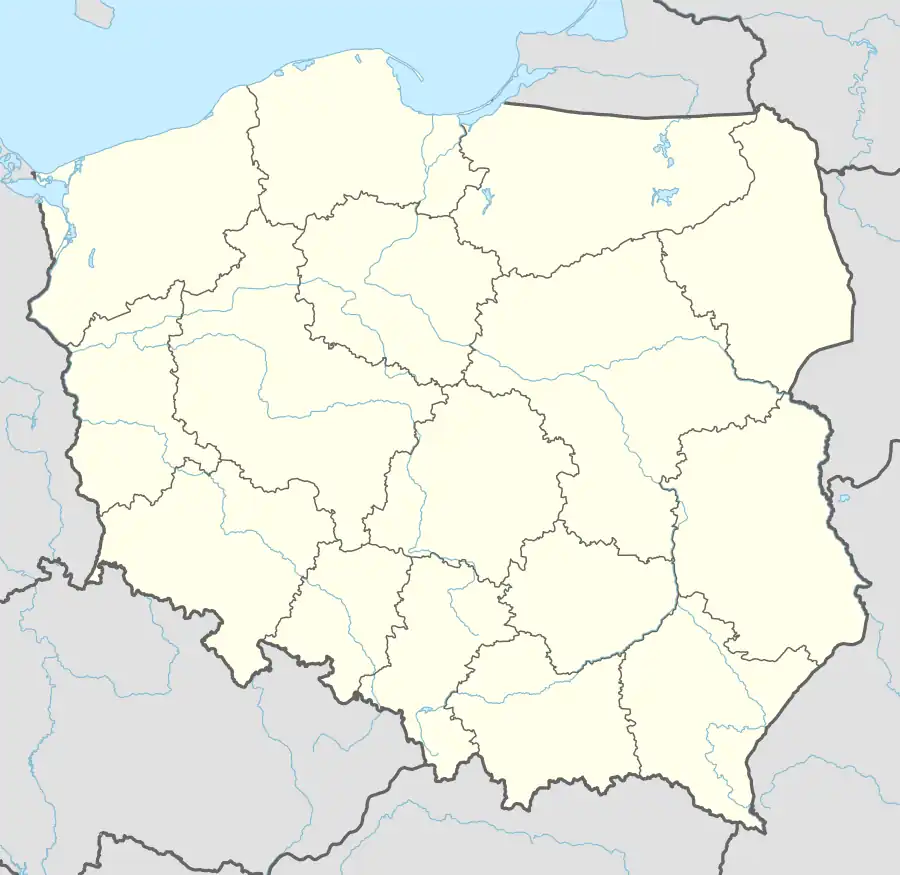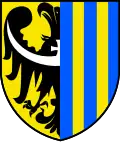Zawidów
Zawidów | |
|---|---|
 Town centre | |
 Coat of arms | |
 Zawidów | |
| Coordinates: 51°1′N 15°4′E / 51.017°N 15.067°E | |
| Country | |
| Voivodeship | |
| County | Zgorzelec |
| Gmina | Zawidów (urban gmina) |
| First mentioned | 1186 |
| Town rights | 1369 |
| Government | |
| • Mayor | Robert Łężny |
| Area | |
• Total | 6.07 km2 (2.34 sq mi) |
| Elevation | 245 m (804 ft) |
| Population (2019-06-30[1]) | |
• Total | 4,180 |
| • Density | 701.6/km2 (1,817/sq mi) |
| Time zone | UTC+1 (CET) |
| • Summer (DST) | UTC+2 (CEST) |
| Postal code | 59-970 |
| Area code | +48 75 |
| Vehicle registration | DZG |
| Website | http://www.zawidow.info |
Zawidów [zaˈvʲiduf] (German: Seidenberg) is a town in Zgorzelec County, Lower Silesian Voivodeship, in south-western Poland, at the Czech border.[2] It lies approximately 14 km (9 mi) south-south-east of Zgorzelec and 139 km (86 mi) west of the regional capital, Wrocław. As of 2019, the town had a population of 4,180.
History
.jpg)
In the Early Middle Ages, Zawidów was a stronghold of the Bieżuńczanie tribe,[3] one of the old Polish tribes.[4] In the early 11th century it was included in the early Polish state by Bolesław I the Brave. The settlement was first mentioned in 1186.[5] In the 14th century it became part of the Bohemian (Czech) Kingdom. It was granted town rights in 1369.[5] In 1397 a school was founded.[5] The town suffered from fires in 1427, 1433, 1469, 1769 and 1834.[5] In 1635 it passed to the Electorate of Saxony and from 1697 was also under the rule of the Kings of Poland. As a result of the Thirty Years' War, Protestants from the Czech Kingdom settled there.[6]
In 1815 it fell to Prussia, and became part of unified Germany. During World War II the German administration confiscated two historic church bells from the local church for armaments.[7] After World War II, the town became again part of Poland under the terms of the post-war Potsdam Agreement.
The old church bells survived the war; however, they are now located in churches in Stuttgart and Ulm in Germany.[7]
Demographics
|
| ||||||||||||||||||||||||||||||
| Source: [8][9] | |||||||||||||||||||||||||||||||
Sports
The local football team is Piast Zawidów.[10] It competes in the lower leagues.
References
- ^ "Population. Size and structure and vital statistics in Poland by territorial division in 2019. As of 30th June". stat.gov.pl. Statistics Poland. 2019-10-15. Retrieved 2020-02-14.
- ^ "Główny Urząd Statystyczny" [Central Statistical Office] (in Polish). To search: Select "Miejscowości (SIMC)" tab, select "fragment (min. 3 znaki)" (minimum 3 characters), enter town name in the field below, click "WYSZUKAJ" (Search).
- ^ Bena, Waldemar (2006). Szlakiem grodzisk słowiańskich i średniowiecznych zamków (in Polish and German). Zgorzelec. pp. 9–10.
{{cite book}}: CS1 maint: location missing publisher (link) - ^ "Plemiona polskie". Encyklopedia Internautica (in Polish). Retrieved 26 December 2020.
- ^ a b c d "Zawidów". Jizerské hory (in Czech). 27 January 2010. Retrieved 15 October 2019.
- ^ "Zawidów". Encyklopedia PWN (in Polish). Retrieved 15 October 2019.
- ^ a b "Z historii Zawidowa: Gdzie są dzwony z wieży kościoła ewangelickiego?". zawidow.eu (in Polish). 21 August 2019. Retrieved 26 December 2020.
- ^ Dokumentacja Geograficzna (in Polish). Vol. 3/4. Warszawa: Instytut Geografii Polskiej Akademii Nauk. 1967. p. 60.
- ^ Stan i struktura ludności oraz ruch naturalny w przekroju terytorialnym w 2010 r. (PDF) (in Polish). Warszawa: Główny Urząd Statystyczny. 2011. p. 50. Archived from the original (PDF) on 13 November 2011.
- ^ "KS Piast Zawidów - nieoficjalna strona klubu" (in Polish). Retrieved 26 December 2020.
